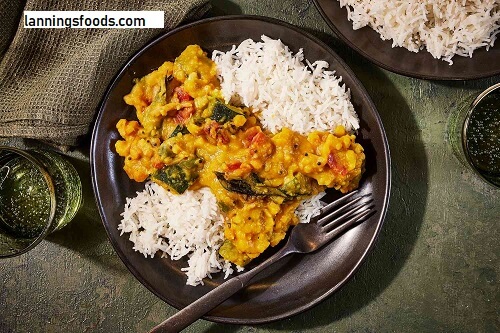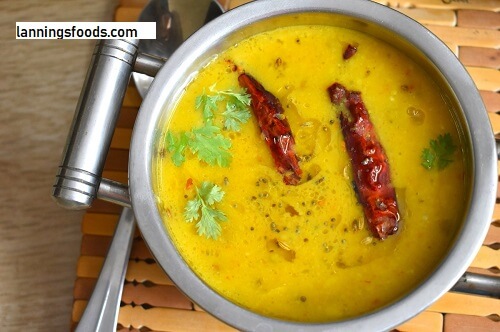Toor Daal Recipe:
Indian Toor Daal Recipe:
I love lentil curries, or dals, and this toor dal with tomatoes and ginger is one of my favourites. This is a recipe my paternal grandmother used for yellow lentils, also referred to as pigeon peas. Thus, even though I ate this growing up, I still make it often. In fact, this is my go-to dal recipe when I’m in the need for some comfort food.
It is quick to prepare and only needs a few ingredients. Probably as easy as it gets. The tomatoes and ginger are the main flavouring elements in this recipe. Along with some tempered cumin seeds and hing, I also put some ghee to my dal. I promise that when you pair this with some steaming hot rice, you will be happy!
Toor Daal Recipe:
To make the lentil curry, I pressure-boiled the dal, tomatoes, and ginger; after that, I added the tempering. You may finish this recipe in less than half an hour. I make this mainly when I’m too lazy to cook or after a lengthy vacation. This dal is a great supper in minutes! I love it best served with a squeeze of lemon over steaming hot rice. Still, this tastes great with naans and rotis. It’s your choice. Both of these tastes are quite excellent. You may also decide to sip it like a lentil soup in this way.

Toor daal:
Toor Daal Recipe
In Hindi, toor dal—also known as arhar dal—is a well-liked lentil dish. This is a common ingredient in many American families’ pantries and can be used in a wide variety of recipes. Though there are more elaborate ways to cook this bean, I usually end up using this simple one. Furthermore, I’ve observed that my loved ones have always appreciated it when I make it for them. After all, nothing compares to the comfort of the most basic meal combo ever—dal chewable.
The ghee, tomatoes, and ginger all have important roles to perform in this recipe. This toor dal with tomatoes and ginger has very little spice, so every bite is infused with the scent of the ghee. And that’s the icing on the cake, as it were! And please, please, please use just ghee instead of oil here. This is because, while oil will still make the dish taste good, ghee gives dal a magical flavor.
Serving recommendations:
Toor Daal Recipe
As previously said, this lentil curry goes well as a side dish with rice, rotis, or any other type of Indian flatbread. You may also serve rice with an onion salad and some papad on the side. A side salad of onions goes great with rotis too. Additionally, when serving your Indian flatbreads with the dal, remember to spread them with extra ghee!
I sincerely hope you would give my easy yet flavorful toor dal dish a try soon. And if you do, I would love to hear from you and see photos of your finished product. You may send me a picture of them on Instagram. Additionally, I would greatly appreciate it if you could leave a remark or rate the dish down below. Wishing you a speedy response!
Components:
Toor Daal Recipe
- 450g (2 cups) of toor dal
- 1 teaspoon ground turmeric
- Two teaspoons of salt
- One teaspoon of sugar
- 160g of sliced mango flesh
- Two tablespoons of ghee
- two finely chopped onions
- three smashed garlic cloves
- easpoon finely chopped ginger.
- Teaspoon of mustard seeds.
- One teaspoon of cumin powder.
- Garam masala.
- Two whole dried red chilies
- Two green chilies, divided
- One stem of mustard seeds

Technique:
Toor Daal Recipe
After washing, add salt, sugar, and turmeric powder to the cooked lentils. In my instant pot, I usually cook lentils by adding 2.5 cups of water to each cup, cooking on high pressure for 8 minutes, and then letting the pressure release naturally. When cooking lentils in a pot, use four cups of water for every cup of lentils, and simmer until the lentils are tender, around 35 minutes.
In a heavy-based pan, heat the ghee, add the onions, and sauté until they are tender. sauté for a further two minutes, then add the garlic and ginger. Turn up the heat a little and add the mustard seeds. Once they start to pop, add the remaining spices.
Add the mango and stir into the cooked lentils. Savor!
Tial Indian Spice Blends for Domestic Cooking:
- Whole and ground cumin has a musty, earthy, and toasty flavor. Cumin is a term that most of us are undoubtedly familiar with.
- Whole and ground coriander has a zesty, citrusy flavor.
- The seeds are rounded and whitish. I use a ton of coriander in my cooking since I think it’s a very useful ingredient and I rarely regret adding an extra teaspoon or two.
- Turmeric powder gives food a vivid yellow hue and a harsh, chalky flavor; nevertheless, when combined with other spices, it becomes a delicious addition to cuisine and does not leave a chalky aftertaste.
- Whole and ground green cardamom has a taste that is herbal and flowery. It is a staple in Indian cookery, both sweet and savory. If you bite it whole, it can be extremely bitter.
- Whole black cardamom: Black cardamom tastes significantly different from green cardamom, imparting a smokey flavor. If you can’t get black cardamom, some people recommend using smoked paprika instead, but I don’t think it tastes as nice.
- Kashmiri chili powder is thought to be of the best quality and gives many meals a lovely red color.
Cooking:
- I usually get the medium or mild types.
- Mustard seeds: the yellow seeds have a milder flavor than the black ones.
- Cinnamon: I’m presuming everyone is familiar with the flavor of cinnamon.
- The cloves: Refer to the earlier explanation.
- The only spice blend I purchase is garam masala, but making it yourself is really not that difficult. Generally speaking, garam masala refers to a ground spice mixture that includes cloves, cinnamon, cardamom, coriander, and cumin. It is necessary to roast, chill, and then grind these spices. If you haven’t roasted the spices, it’s not truly garam masala. Then, as mentioned, you can include this into your recipes.
- Certain recipes do specify entire garam masala, which is a blend of the previously listed spices that are toasted rather than ground. Using complete garam masala is like using “aromatics” in a western cookery; that is, you utilize the herb sprig to infuse the flavor throughout the dish while it slowly cooks, rather than eating the entire sprig.

Delicious but Less Important Indian Spices for the Home Cook:
- Dried Kasuri Methi Leaves: Often referred to as Fenugreek, this herb can be used fresh or dried and adds a faint taste that you may be able to detect in many Indian restaurant curries.
- Whole methi seeds, also called fenugreek seeds, give a delicate sweetness to a variety of recipes. However, if the seeds are not roasted before usage, the flavor will be overpoweringly bitter. This goes into my go-to recipe for Chicken Tikka Masala.
- Dried mango powder, or amchoor powder, gives a tart taste to a variety of cuisines. In recipes, you can use lemon juice instead, but the flavor won’t be exactly the same. Although I think amchoor powder is optional, I really like it.
- Asafoetida/Hing: I honestly won’t keep this ingredient in my home because it makes my kitchen smell terrible and gives me terrible headaches, but if you’re genuinely dedicated to authenticity, you might want to give it some thought.
- It is particularly popular in some Indian regions and social groups where onions and garlic are not used in cooking, and it has a strong, garlicky flavor. I’ve discovered that if a recipe calls for this, you can simply add a little extra garlic and not notice the difference.
- Fun facts: it’s also known as Devil’s Dung, and it seems to have anti-flatulent properties.